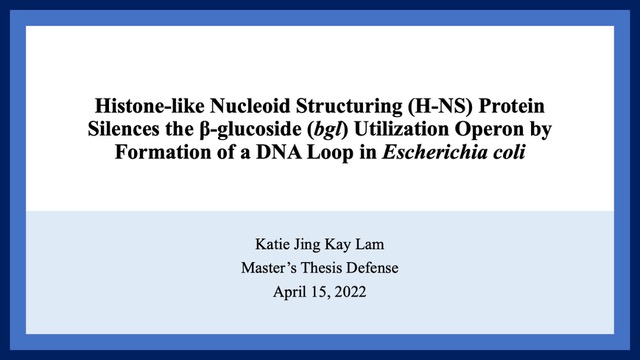Congratulations to our grad student Katie Jing Kay Lam for the successful defense of her Master’s thesis on April 15, 2022. The title of her thesis is “Histone-like Nucleoid Structuring (H-NS) Protein Silences the β-Glucoside (bgl) Utilization Operon by Formation of a DNA Loop in Escherichia coli.”
Abstract
The β-glucoside (bgl) utilization operon in Escherichia coli encodes proteins necessary for uptake and hydrolysis of aromatic β-glucosides. The bgl operon is silent in wild-type cells due to strong repression by the histone-like nucleoid structuring (H-NS) protein, which binds to the upstream bgl regulatory region and within the bglG gene. In addition to its DNA-binding domain, H-NS contains a dimerization/oligomerization domain, allowing formation of oligomeric nucleoprotein complexes which are important for gene silencing. In this study, we demonstrate that silencing of the bgl operon is due to the self-oligomerization of the dimeric H- NS protein, which brings the two H-NS binding sites within the bgl operon together, leading to formation of a DNA loop that largely blocks the operon transcription. Our results show that the bgl operon can be activated, or partially activated, by preventing H-NS self-oligomerization, and by reducing H-NS binding to either of its two binding sites within the operon. H-NS binding alone with no looping is not capable of efficiently repressing the operon, and other regulators are not required for operon repression. This indicates that formation of the H-NS-mediated DNA loop is necessary and sufficient to silence the bgl operon expression. In addition, we have found that formation of the DNA loop in the bgl operon is flexible and is independent of the distance between and the DNA phasing of the two H-NS binding sites in the DNA helix. Overall, our results revealed that H-NS-mediated DNA looping is robust and strongly represses transcription of the bgl operon.


